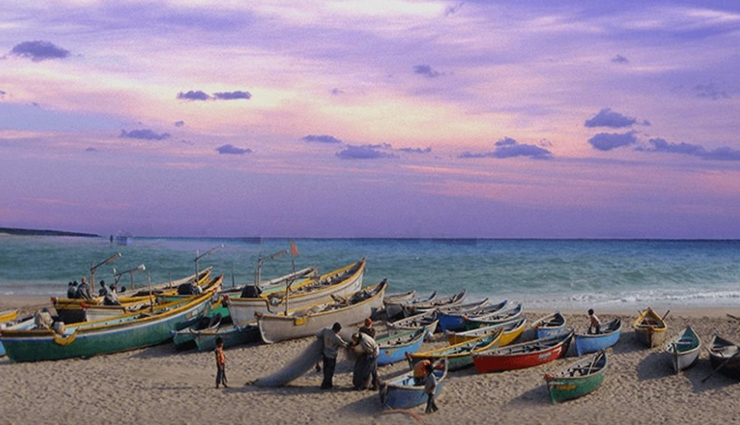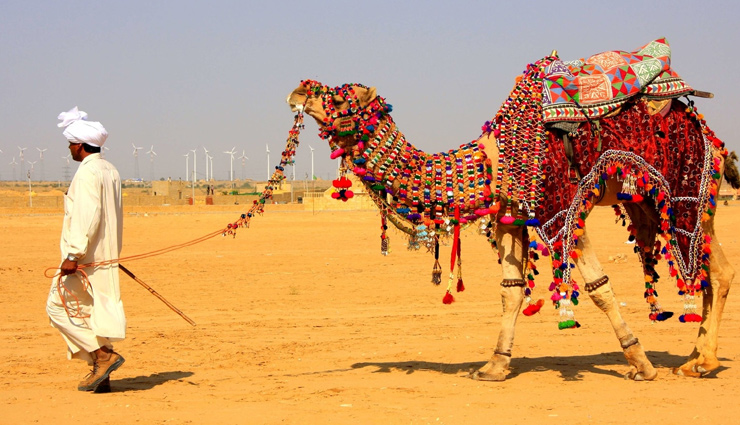Narayan Sarovar is a major pilgrimage site for Hindus in the Lakhpat taluka of Kutch district of Gujarat. This lake is one of the five holy lakes of Hindus. Here the Indus River meets the ocean. Narayan Sarovar is related to Lord Vishnu. There is an ancient and grand temple of Lord Adinarayan on the banks of Narayan Sarovar. Along with this, the temples of Trikamraiji, Laxminarayanji, Govardhannathji, Dwarkanathji, Ranchhodrayji, and Lakshmiji are also built here. It is believed that the construction of these temples was done by the wife of Maharao Desalji. Four kilometers away from here is the famous Koteshwar Shiva temple.

The holy Narayan Sarovar has also been described in Shrimad Bhagwat. According to Srimad Bhagwat, Dasapachetas, the son of King Barhish, did penance at this place to get a son. Daspachetas kept chanting Rudra here for about 10 thousand years after listening to Rudragan from Lord Rudra. God was pleased with his penance and he was blessed with a son, who was named Daksha Prajapati.
One of the five important lakes, Narayan Sarovar is related to Lord Vishnu. The names of the other lakes are Man Sarovar, Bindu Sarovar, Pampa Sarovar, and Pushkar Sarovar.
Where is Narayan Sarovar: Narayan Sarovar is located in Lakhpat Tehsil of Kutch district of Gujarat. To reach Narayan Sarovar, first, reach Bhuj. One can come by rail from Delhi, Mumbai, and Ahmedabad to Bhuj.
Two ancient temples: There is an ancient and magnificent temple of Lord Adinarayan on the banks of the holy Narayan Sarovar. The ancient Koteshwar Temple is at a distance of 4 km from here.
- Sarovar is at the confluence of Indus: 'Narayan Sarovar' means- 'Vishnu's lake'. Here the Indus River meets the ocean. The holy Narayan Sarovar is situated on the bank of this confluence. The discussion of this holy Narayan Sarovar is found in Shrimad Bhagwat.
- Visits of famous people: In this holy lake there are incidents of the arrival of many sages of ancient times. Adya Shankaracharya also came here. Chinese traveler Hiuen Tsang has also discussed this lake in his book 'Cyuqi'.
- Grand fair: A grand fair of 3 days is organized in Narayan Sarovar from Kartik Purnima. Sadhus-sanyasis and other devotees from all sects of North India participate in this. Devotees also perform the Shradh of their ancestors in Narayan Sarovar.
Mythology
Local people believe about Narayan Sarovar that there was once a severe drought in the mythological era. To get out of this crisis, the sages had done a lot of penance to Lord Vishnu. Pleased with the penance of the sages, Lord Vishnu appeared in the form of Narayana and touched the ground with his toe. With the touch of Lord Vishnu, a lake was formed there, which is known as Narayan Sarovar.
People have deep faith in Narayan Sarovar. Every year lakhs of devotees come to Narayan Sarovar to take a dip. It is believed that Lord Vishnu took a bath here. That's why taking a dip in this lake leads to salvation. Every year on the occasion of Kartik Purnima, a three-day fair is also held here. Sages-saints and devotees from all sects of North India come to this fair. Devotees also perform the Shradh of their ancestors in Narayan Sarovar. It is believed that many Saints and Mahatmas had visited this place in ancient times. Adi Guru Shankaracharya also came to this place.
Lakhpat Fort
Only 33 km north of Narayan Sarovar lies the town of Lakhpat, which has a walled fort as its main attraction. The city was an important coastal trading center in the 18th century. At the mouth of Kori Creek, the massive fort walls still stand testimony to a short but glorious past. One can climb the ramparts of the fort, the only remaining structure of the fort, and look out over the calm sea. The place is especially stunning at sunset. There is also a 16th-century Gurudwara within the fort walls. Guru Nanak is believed to have stayed here twice during his second (1506–1513) and fourth (1519–1521) missionary journeys, called Udasi. The Gurudwara is a pleasant place for travelers. Gentle hymns play continuously in the background as travelers visit the ancient Sikh place of worship to view relics such as wooden shoes, palanquins (palanquins), manuscripts, and icons of two important heads of the Udasi sect.

Gurudwara Lakhpat Sahib
It is a historical Gurudwara associated with Guru Nanak. Gurdwara Lakhpat Sahib is also located in the old fort of Lakhpat. In front of Guru Darbar, there is a big wooden palanquin in which two pairs of historic wooden stands are kept for the darshan of the Sangat. It is said that these two pairs of wooden stands belong to Guru Nanak Dev Ji and his son Baba Shri Chand Ji. To the left of the Guru Darbar, the Guru Granth Sahib is seated in a beautiful palanquin. Sukhmani is recited here on Sundays, for which Sikh Sangats from the Kutch region come to Gurdwara Sahib. Hearing the words of Sukhmani, the hearts of the people present there become happy. There is also a langar hall, where food is arranged for the visitors. Here every person is served prasad, dal, rice, water, and pickle along with a pinch of salt on a plate because the amount of salt in the air and water here is very high. If someone feels less salt, So he can add a pinch of salt to the dal.
History of Gurdwara Lakhpat Sahib
Gurdwara Lakhpat Sahib is located near the border with Pakistan, 135 km from Bhuj in the Kutch district of Gujarat. This historical place has the touch of Guru Nanak Dev Ji and Baba Shri Chand Ji. Guru Nanak Dev Ji came here twice, the first time when he went to Mecca on his journey to the West. Lakhpat was a very big port on the coast of Sindh, boats were also available. By this route Guru ji also went to Mecca in handcuffs. At that time Lakhpat was part of Sindh province, now Kutch of Gujarat, the Indus River flows to the far west. Pakistan's largest city Karachi is just 250 km away from Lakhpat. The Guru came here for the second time on his return to Punjab due to the sadness of the South. The historical wooden slippers of Guru Ji and Baba Shri Chand Ji are also kept in Lakhpat Gurdwara Sahib. The Bhuj earthquake in 2001 heavily damaged the building of Gurdwara Sahib but the building of Guru Ghar has been built in the same way. Similarly, Gurdwara Lakhpat Sahib has been awarded the UNESCO Asia Pacific Award in 2004 for maintaining this historical building as the Guru Ghar has retained its heritage even after the 2001 earthquake.
A grand fair is held in Narayan Sarovar
A 3-day grand fair is organized here from Kartik Purnima, in which saints and other devotees of all sects of Uttar Pradesh participate, devotees also perform the Shradh of their ancestors in Narayan Sarovar. Devotees come here to calm their minds.
Aina Mahal
This beautiful palace in Bhuj, built in 1752, lost its top floor in an earthquake, but the lower floor is open to visitors, with a magnificent 15.2-meter scroll showing the Kutch state procession. The palace is one of three that are located in the walled complex in the old part of the city. The elaborately mirrored 18th-century interior is a showcase for all things European—a reverse mirror of European Orientalism—with blue-and-white Delphi-style tiles, a candelabra with Venetian-glass shades, and the Harding lithograph series. Rake progress. From the top of the tower, there are spectacular views of Rani Mahal. The palace was built for Maharao Lakhpatji by Ram Singh Malam, a boatman from Dwarka, who visited him during his voyage.
Koteshwar Mahadev Temple
After traveling through the vastness of the desert in Western Kutch, you find the Koteshwar Temple at a point where the vastness of dry land meets the immeasurable vastness of the sea. After such a barren land, the view of the sea will wake up your spirits; Although the ocean is even less hospitable to humans, it is a serious consideration. The last outpost of man-making on India's westernmost frontier, the point of Koteshwar Temple is the only point that breaks the horizon from the flat gray horizon to the east and the broad blue horizon to the west. Not teeming with tourists like the temple at Dwarka, Koteshwar is suited for contemplating emptiness, for contemplating humanity's place on earth (and ultimately, what about spiritual traditions?).

The story of Koteshwar begins with Ravana, who won a boon from Lord Shiva for his excellent display of piety. This boon was the gift of a Shiva Linga of great spiritual power, but Ravana in his arrogant haste accidentally dropped it and it fell to the earth at Koteshwar. To punish Ravana for his carelessness, the linga turned into a thousand identical copies (some versions of the story say ten thousand, some a million; suffice it to say it was enough.) Unable to distinguish the original, Ravana grabbed one and left, leaving the original here, around which the Koteshwar temple was built.
(PC: Lifeberrys)










